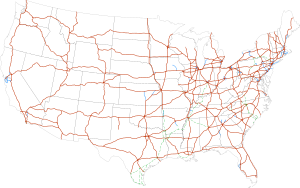
Back 州間高速道路通勤別線 Japanese Lista de rotas de negócio do Sistema Interestadual de Autoestradas dos Estados Unidos Portuguese Danh sách xa lộ thương mại thuộc Hệ thống Xa lộ Liên tiểu bang Vietnamese
| Dwight D. Eisenhower National System of Interstate and Defense Highways | |
|---|---|
Highway shields for Business Loop Interstate 24 and Business Spur Interstate 196 | |
 Interstate Highways in the 48 contiguous states | |
| System information | |
| Formed | June 29, 1956[1] |
| Highway names | |
| Interstates | Interstate nn (I-nn) |
| Business Loop: | Business Loop Interstate nn (BL I-nn) Interstate nn Business Loop (I-nn Bus. or I-nn BL) |
| Business Spur: | Business Spur Interstate nn (BS I-nn) Interstate nn Business Spur (I-nn Bus. or I-nn BS) |
| System links | |
The Interstate Highway System of the United States, in addition to being a network of freeways, also includes a number of business routes assigned by the American Association of State Highway and Transportation Officials (AASHTO). These routes connect a central or commercial district of a city or town with an Interstate bypass.
As the main purpose of these routes are to serve a certain downtown area, business Interstates are typically routed along surface roads. These routes do not have to meet Interstate Highway standards and are not considered part of the Interstate Highway System. AASHTO does, however, apply similar standards as to new U.S. Highways, requiring a new business Interstate to meet certain design standards.[2]
Business Interstates are more commonly found in the western regions of the United States, as well as both across the Great Plains and in the state of Michigan. In contrast, Eastern states generally did not designate as many business Interstates. This geographic difference can be attributed to the way the Interstate Highway System was constructed in different parts of the country. In many eastern states, the new Interstates were often built to parallel the existing U.S. Highway network, rather than directly replacing those older routes. With the exception of mountainous areas, this left the majority of U.S. Highways intact, or co-signed routes with the Interstates. However, in the western states, the construction of the Interstate system more frequently involved directly overlaying the former U.S. Highway alignments. This sometimes left sections of the old U.S. Highways disconnected, especially in rural areas between cities and towns. To maintain access to those former highway segments, business Interstate designations were often applied as a way to guide drivers to key commercial districts and services. Although business Interstates are primarily found along primary Interstates, a few auxiliary Interstates also have their own business route designations.[3]
Like auxiliary Interstates, business Interstates can be repeated from state to state along their route. The only difference is that business Interstates can also be repeated in several locations within the same state.
| Contents: |
|---|
- ^ Weingroff, Richard F. (Summer 1996). "Federal-Aid Highway Act of 1956, Creating the Interstate System". Public Roads. 60 (1). Washington, DC: Federal Highway Administration. Retrieved March 16, 2012.
- ^ Special Committee on U.S. Route Numbering (November 15, 1997). "Report of the Special Committee on U.S. Route Numbering to the Standing Committee on Highways" (PDF) (Report). Washington, DC: American Association of State Highway and Transportation Officials. Archived from the original (PDF) on October 16, 2017. Retrieved June 15, 2024.
- ^ M, Brenton (May 31, 2018). "Business Route Guide". AARoads. Retrieved June 16, 2024.[self-published source]

